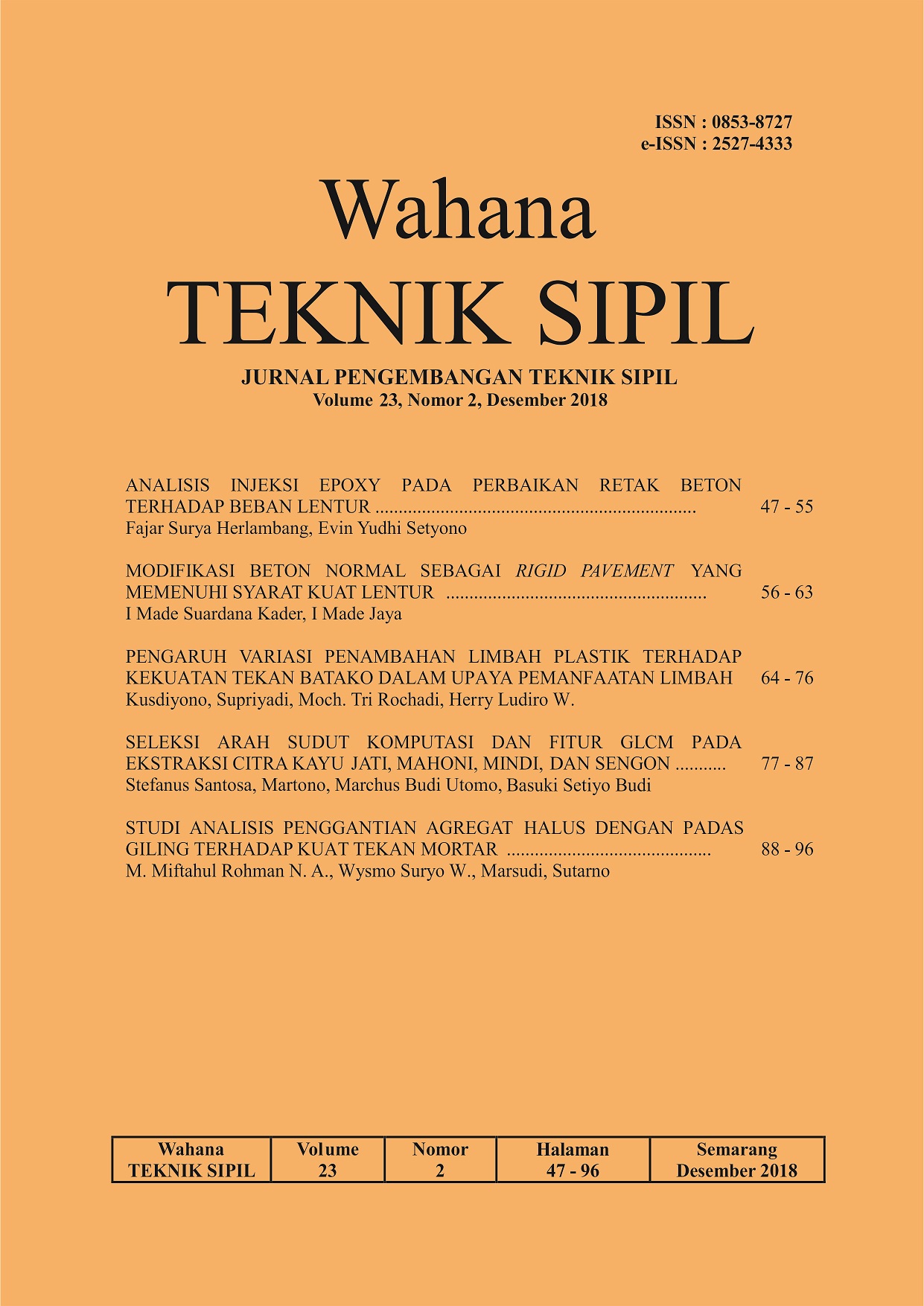Modifikasi Beton Normal Sebagai Rigid Pavement Yang Memenuhi Syarat Kuat Lentur
DOI:
https://doi.org/10.32497/wahanats.v23i2.1361Abstract
Minimum specification of concrete flexural strength for rigid pavement structure is 4.5 MPa. If it is estimated, the concrete quality that meets these requirements is f'c 41. To get concrete f'c 41 requires very good material, measurable methods of implementation and strict supervision. Therefore, the procurement of concrete is very expensive. In addition to price issues, the provision of coarse aggregates with specific gravity above 2.5 in Bali Province is still difficult. Under these conditions, normal concrete is designed but meets the requirements by 1) adding wire fibers with a variation of 0.5%, 0.75%, 1%, 3% and 5% of the concrete weight and 2) giving a layer of carbon fiber under a layer of concrete without resin adhesive. The results of the study revealed that the addition of wire fibers of less than 5% turned out to make the value of flexural strength lower than without wire, so that at 5% wire content the flexural strength slightly exceeded the flexural strength without wire. The value of flexural strength without wire is 4.57 MPa, flexural strength with a 5% wire content is 4.94 MPa, resulting in a difference of 0.44 MPa or greater 9.47%. For flexural strength with carbon fiber layer at the bottom, the value of flexural strength increased significantly to 5.63 MPa or about 25.10%. This is understandable because carbon fiber has a high tensile strength pecification and is the main material in retrofit activity.
Kata kunci : rigid pavement, flexural strenght, wire fibers, carbon fiber
References
Aris Widodo, 2012, “Pengaruh Penggunaan Potongan Kawat Bendrat Pada Campuran Beton Dengan Konsentrasi Serat Panjang 4 Cm Berat Semen 350 Kg/M3 Dan Fas 0,5”, Jurnal TEKNIK SIPIL & PERENCANAAN, Universitas Negeri Semarang (UNNES), Nomor 2 Volume 14 ”“ Juli 2012, hal: 131 ”“ 140.
Emon, Adul Basar. MD., 2014, “Study of Strength and Ductility of Galvanized Iron Wire Reinforced Concrete”, Thesis, Bangladesh University of Engineering and Technology,
Fawzi Julianto, Eddy Samsurizal, Crisna jaja Mungok, 2016, Pengaruh Campuran Kawat Bendrat terhadap Kekuatan Balok Beton dengan Mutu 20 MPa”, Jurnal Mahasiswa Teknik Sipil Universitas Tanjungpura, Volume 2, Nomor 2.
Kader, I Made Suardana dan I Made Jaya, 2013, “Analisis pola retak dan mekanisme kegagalan balok beton bertuang dengan perkuatan lentur lembar CFRD”, Jurnal LOGIC, Vol. 13, No. 3, hlm. 87- 95, Bali.
Nugraha, Paul dan Antoni, 2004, “Teknologi Beton dari material, Pembuatan, ke Beton Kinerja Tinggi”, LPPM Univ. Kristen Petra dan Penerbit Andi, Yogyakarta.
Rony Foermansah, 2013, “Tinjauan Kuat Tekan dan Kuat Tarik Belah Beton dengan Serat Kawat Bendrat Berbentuk Z sebagai Bahan Tambah”, Skripsi, Program Studi Teknik Sipil
Fakultas Teknik Universitas Muhammadiyah Surakarta, Surakarta.
Soebandono, Bagus. dkk., 2011, “Perbaikan Balok Beton Bertulang dengan Metode Jacketing dengan Bahan Ferosemen Akibat Beban Siklik pada Beban Ultimit”, Jurnal Ilmiah Semesta Teknika, Vo. 14, No, 2, Hal. 166-176, Yogyakarta.
Spesifikasi Teknis, 2016, Pelelangan Pengusahaan Jalan Tol, Batang- Semarang, Panitia Pelelangan Pengusaan Jalan Tol, Kementrian Pekerjaan Umum dan Perumahan Rakyat, Jakarta.
Spesifikasi woven roving, Nitrowrap FRC, Fosroc.
Downloads
Published
Issue
Section
License
Authors who publish with this journal agree to the following terms:Authors retain copyright and grant the journal right of first publication with the work simultaneously licensed under a Creative Commons Attribution License that allows others to share the work with an acknowledgement of the work's authorship and initial publication in this journal.
Authors are able to enter into separate, additional contractual arrangements for the non-exclusive distribution of the journal's published version of the work (e.g., post it to an institutional repository or publish it in a book), with an acknowledgement of its initial publication in this journal.
Authors are permitted and encouraged to post their work online (e.g., in institutional repositories or on their website) prior to and during the submission process, as it can lead to productive exchanges, as well as earlier and greater citation of published work (See The Effect of Open Access).






